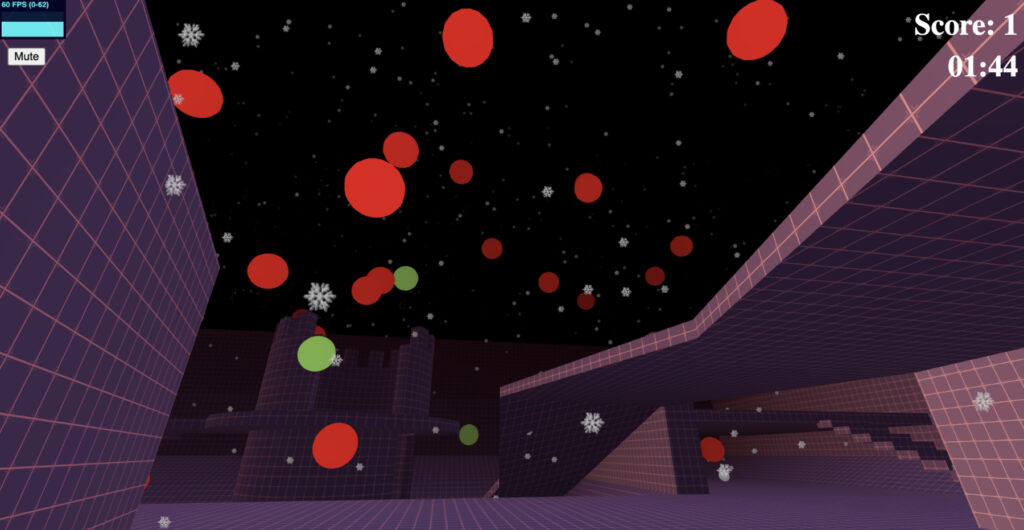Mercer University graduate students in an advanced software engineering class closed out the spring semester with an unusual final project: a contest to see who could create the best online game.
Students in Dr. Michael Pelosi’s advanced graphic interfaces course learned how to develop sophisticated graphic user interfaces, through which users interact with digital content via icons and other graphic elements.
In the past, advanced graphics, like the kind found in 3D games, were primarily limited to running on local computers. Technology has advanced so now these types of games, like Minecraft and Roblox, can be played on the web, said Dr. Pelosi, associate professor of software engineering in the School of Engineering.
“For any software engineer, if you can do the web programming type of graphics, that’s kind of state of the art at the moment,” he said. “That allows users to not have to install any software. They just go to the web page, and everything is running.”
Students used Three.js, an open-source programming library, to create and display 3D graphics online.
“Learning the software interface is just one part of it. The students have to become creative to use 3D graphics,” Dr. Pelosi said. “It’s not enough just to be able to be proficient with programming the software. You have to come up with something that’s got a compelling, let’s say market value, for someone to actually want to play it.”
Advanced graphic interfaces also are powerful tools for creating engineering simulations, such as the movement of air around an airplane, or training simulations, like those used by law enforcement, Dr. Pelosi said. So, students were given the option to create a simulation rather than a game for the contest.
Evan Mullvain, who graduated with his Master of Science in Engineering in May, built a hurricane visualization using data from the National Oceanic and Atmospheric Administration. The interactive tracker shows the path and strength of hurricanes from 1851-2024. He received an honorable mention for his work.
First place went to Christine Ta for her game, Man, Those Ships Look Dangerous, which was inspired by the classic arcade game Galaga. In Ta’s game, the player must attack enemy spaceships while also avoiding enemy fire.
“In the vote, her peers said Christine pulled off the holy grail, the almost impossible dream of addictive gameplay,” Dr. Pelosi said. “She kind of rolled it all together including the programming part but also the creative and the game design part for addictive gameplay and came up with a very simple game to play that’s really got a lot of popularity so far.”
After emailing her game out to School of Engineering students, the game briefly crashed her server, he said. (Anyone can play these games by clicking the hyperlinks in this story.)
Ta said she grew up playing video games, including Galaga. While the game was first released as an arcade game in 1981, it’s now widely available to play online.
“It was something simple, something fun. You could do it over and over again, just trying to beat your high score,” she said. “And I know other people probably played it in their childhood as well, so I kind of wanted to also replicate that nostalgia factor.”
Ta, who is pursuing a master’s degree in software engineering, currently works as an electronics engineer at Robins Air Force Base and develops games on the side as a passion project. Three.js was new to her, and learning it was challenging but worthwhile, she said.
She said she hopes to use her new degree to move into a software engineering role with the Space Force.
Four games tied for second place: Winter Sky Arena by Kandice Estrella; Red Light, Green Light by Alexis Evans; Baaah-tlship by Carmen Mueller; and Interdimensional Pool by Michael Young. Third place went to Dungeon Rogue by Joel Seepersaud.

In Winter Sky Arena, users throw snowballs at green targets while avoiding red enemies. Estrella, who is pursuing a Master of Science in software systems, said she got the idea from first-person shooter games and made the theme based on her favorite season — winter.
She said she liked that the project had a tangible result that she could share with others, and she enjoyed seeing her classmates’ games as well.
“Playing everyone’s games kind of gave me ideas for projects I might want to do in the future,” she said.
Game programming is one of the most difficult forms of programming and software engineering, Dr. Pelosi said. Having a project such as this on a resume is a boost to an applicant’s credibility when interviewing for a software engineering job, he said.
“You have to, more or less, be a master of many different areas, one of which is graphics. But if you’ve got a game with something like car crashes or billiard balls, you have to model physics, model the real world,” he said. “You have to do networking if there’s a multiplayer aspect to the game, and your code has to run quickly because no one’s going to tolerate a slow game, so you have to be good at optimization. And to top it off, you’ve got to come up with some kind of addictive gameplay. The students seem to have mastered it.”










